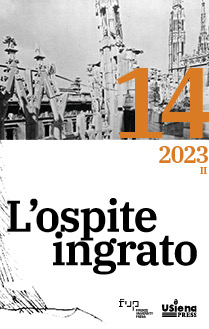L’endecasillabo nelle poesie di Vittorio Sereni. Gli strumenti umani e Stella Variabile
Published 2023-12-22
Keywords
- Vittorio Sereni,
- contemporary Italian poetry,
- stylistics,
- hendecasyllable,
- Neo-Avant-garde
How to Cite
Copyright (c) 2023 Andrea Piasentini

This work is licensed under a Creative Commons Attribution 4.0 International License.
Abstract
The contribution declines the theme of rubble at a formal level, analysing the persistence of the hendecasyllable in Vittorio Sereni’s last two books, Gli strumenti umani (1965) and Stella variabile (1981). The hendecasyllable can be seen, in fact, as the key element of a system that undergoes a crisis at the beginning of the 20th century and is radically renewed in the middle of the century. The first part of the article summarises three different interpretations of the endecasyllable, to provide a historical context for Sereni’s writing. Mario Luzi and the Neo-avant-garde (represented by the essay Il verso secondo l’orecchio by Alfredo Giuliani) are in specular oppositions: the former argues in favour of the consubstantiality of the hendecasyllable to the Italian language, resorting to it as a guarantee of formal order; the others, on the contrary, declare the end of traditional verse, and see the hendecasyllable as a poison, an element against which to rebel. Giorgio Caproni’s interpretation at the height of the mid-1950s is equally historicist and formulated in a positive sense as in Luzi: the poet finds safety in the metrical «roof» that can contain the risk of private and collective dissolution. Vittorio Sereni, on the other hand, already with his first two collections Frontiera (1941) and Diario d’Algeria (1947), but above all with the turning point marked in the mid Sixties by Gli strumenti umani (1965), opens up the rhythmic structure of the hendecasyllable, focusing on unconventional rhythmic profiles and above all bending it to the movements of his own voice (rhetorical-argumentative stylistic features) and to those of inner speech – in short, he works towards a greater subjectivation of the metre. The second and third parts of the article focus first on two texts emblematic of the style of Strumenti umani and Stella variabile, and then extend the analysis to some specific traits of Sereni’s stylistic evolution from one book to the next, describing and interpreting concrete phenomena in the reuse of the hendecasyllable.

